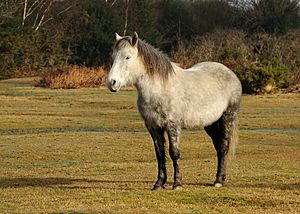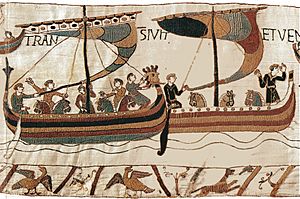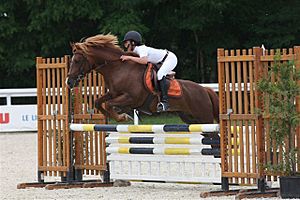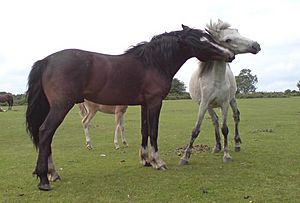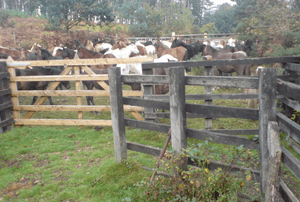New Forest pony facts for kids
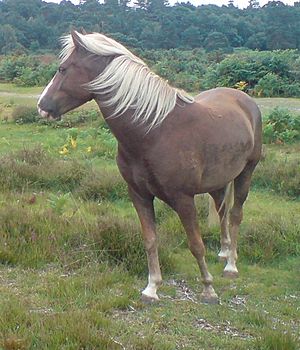
New Forest pony at Spy Holms
|
|
| Distinguishing features | Very sturdy with plenty of speed, can be ridden by children or adults, all colours are acceptable except piebald, skewbald, and blue-eyed cream, but most are bay, chestnut, or grey |
|---|---|
| Country of origin | England |
| Breed standards | |
| New Forest Pony Breeding and Cattle Society | Breed standards |
| New Forest Pony Society of North America | Breed standards |
| Horse (Equus ferus caballus) | |
The New Forest pony is a special type of pony from the British Isles. It's known as a "mountain and moorland" or "native" breed. These ponies are usually between 12 and 14.2 hands tall. They are strong and good for riding. People like them because they are tough, strong, and very good at walking on tricky ground.
These ponies have lived in the New Forest area of Hampshire, England, for a very long time. Bones found there show horses lived there even before the last Ice Age. DNA studies show they are related to ancient ponies like the Asturcón and Pottok. Today, only ponies whose parents are both registered as purebred can be called purebred New Forest ponies. These ponies are great for both kids and adults to ride. They can also pull carts and do well in horse shows against bigger horses.
All ponies grazing in the New Forest belong to local people called "commoners." These people have the right to let their animals graze on the Forest lands. They pay a yearly fee for each pony. The number of ponies in the Forest has changed over time. In 1945, there were fewer than 600, but now thousands live freely in a semi-feral way. Special workers called Agisters look after the ponies' health. They work for the Verderers of the New Forest. Each year, the ponies are gathered in "drifts" to be checked, given medicine, and have their tails marked. Purebred New Forest stallions are allowed to run with the mares for a short time each year. Many young ponies born in the Forest are sold at special sales.
Contents
What Do New Forest Ponies Look Like?
The New Forest Pony Breeding and Cattle Society sets the rules for what the ponies should look like. The tallest they can be is 14.2 and a quarter hands. There's no minimum height, but they are usually at least 12 hands tall. In shows, they are often split into two groups based on height.
New Forest ponies should be good for riding and have strong bodies. They have sloped shoulders and powerful back legs. Their bodies are deep, and their legs are straight with strong, flat bones. They have hard, round hooves. Even the larger ponies are narrow enough for small children to ride comfortably. They can also carry adults. Smaller ponies might not be best for heavier riders, but they often look very good for shows. These ponies have smooth, active, and straight gaits. They are known for being sure-footed, quick, and agile.
Common Colors and Markings
The most common colors for these ponies are bay, chestnut, or grey. Some colors are not allowed, such as piebald, skewbald, and blue-eyed cream. Palomino and very light chestnut ponies can only be registered as geldings (male horses that cannot breed) or mares (female horses). Blue eyes are never allowed.
White markings are allowed on their heads and lower legs. But they cannot have white markings behind the head, above the hock on the back leg, or above the knee on the front leg. Ponies that don't meet these rules cannot be registered as purebred.
Health and Temperament
New Forest ponies are known for being gentle and smart. They are strong and can do many different things. Overall, they are a very tough and hardy breed.
There is one known genetic health issue in the breed called congenital myotonia. This is a muscle condition. It was found in the Netherlands in 2009. Scientists found that affected foals get this condition if both parents carry a specific gene. Breeders are now testing ponies to make sure this gene is removed from the breeding stock. This helps keep the ponies healthy.
History of New Forest Ponies
Ponies have lived in the New Forest area for thousands of years. Horse bones found from the Bronze Age suggest they looked like the modern Exmoor pony. Bones from the Iron Age show ponies were about 12 hands tall, similar to some New Forest ponies today.
When William the Conqueror invaded England in 1066, he brought over two thousand horses. The first written records of horses in the New Forest are from this time. People were given rights to graze their animals there. There's a story that New Forest ponies came from Spanish horses that swam ashore from wrecked ships. But this is now thought to be a myth. However, a study in 1998 showed that New Forest ponies do share old family ties with two Spanish pony breeds, the Asturcón and Pottok.
An important stallion in the breed's early history was a Thoroughbred named Marske. He was the father of the famous racehorse Eclipse. Marske was used to breed with local mares in the 1760s.
In the late 1800s, the quality of the ponies started to decline. People thought adding Arab blood would help. The number of ponies in the Forest also dropped. This might have been because the Arab blood made them less hardy for living on the open Forest in winter. Also, people wanted more refined ponies for riding before cars became common. During World War II, many young ponies were sold for meat, which also reduced their numbers.
In 1891, a society was formed to improve New Forest ponies. They held shows and encouraged owners to use good stallions. In 1937, two societies merged to form the New Forest Pony Breeding and Cattle Society. This group started keeping a stud book.
The number of ponies grazing in the Forest kept changing. In 1945, there were only 571 ponies. By 2011, there were over 4,600. In 2014, a group called the Rare Breeds Survival Trust listed the New Forest pony as a "minority breed." This was because the number of foals born each year had dropped a lot. This change was due to a weaker market and efforts to improve the quality of foals, not just the quantity.
Over time, other breeds like Arabian, Thoroughbred, Welsh pony, and Hackney were mixed with New Forest ponies. But this meant the hardier ponies were sold off. To fix this, ponies from other British native breeds like the Fell, Dales, Highland, Dartmoor, and Exmoor were brought in. This stopped in 1930. Since then, only purebred New Forest stallions are allowed to breed in the Forest. New Forest ponies have been sent to many countries, including Canada, the U.S., Europe, and Australia. Many of these countries now have their own groups and stud books for the breed.
How New Forest Ponies Are Used
In the past, smaller New Forest ponies worked in mines. Today, they are still the top choice for local farmers and commoners. Their sure-footedness and agility help them move safely across the Forest's tricky ground. This is especially useful during the autumn "drifts" when ponies are gathered.
New Forest ponies are also used for many fun activities today. These include gymkhanas (horse games), show jumping, cross-country riding, dressage, driving carts, and eventing.
These ponies can carry adults and often compete well against larger horses. For example, in 2010, a club called the New Forest Pony Enthusiasts Club won a national competition at the London International Horse Show. Their team only used purebred New Forest ponies. This showed how capable these ponies are.
Ponies on the New Forest
The ponies grazing in the New Forest are a famous sight. They, along with cattle, donkeys, pigs, and sheep, have helped shape the Forest. Their grazing for over a thousand years created the New Forest ecosystem we see today.
The animals in the New Forest are not completely wild. They are owned by commoners, who pay a yearly fee. The commoners and the Agisters look after the animals. The Agisters are employees of the Verderers of the New Forest. The Verderers are an old group that helps manage the Forest with the Forestry Commission and the National park authority. About 80% of the animals in the Forest belong to only 10% of the commoner families.
Most ponies living full-time in the New Forest are mares (females). There are also a few geldings (males that cannot breed). For most of the year, ponies live in small groups. These groups usually have an older mare, her daughters, and their foals. They tend to stay in a specific area of the Forest called a "haunt." While most ponies are New Foresters, other breeds like Shetlands can also be found.
Stallions (male horses used for breeding) must be registered New Foresters. They are not allowed to run free all year. They are usually turned out only for a short time in spring and summer. During this time, they gather groups of mares and young ponies. They protect their herds from other stallions. This limited breeding time ensures foals are born at the right time of year.
Young male ponies are checked at two years old to see if they are suitable to become stallions. If they don't pass, they must be gelded. Each spring, approved stallions must pass another check by the Verderers before they can go into the Forest to breed. To keep the ponies hardy, the Verderers started a project to increase genetic diversity. They breed older, tough Forest mares with stallions that haven't lived in the Forest or are not closely related to those that have.
Ponies are gathered in "drifts" in the autumn. Most young males and some young females are removed. Any animals that are too thin to stay in the Forest over winter are also taken out. The remaining young females are marked with their owner's brand. Many animals are also given medicine for worms. Many owners take some animals off the Forest for winter and bring them back in spring. Ponies that owners don't need are often sold at the Beaulieu Road Pony Sales. The ponies' tail hair is trimmed in a special pattern. This shows that their grazing fees have been paid. Each Agister has a unique tail-mark for their area. Agisters constantly watch the ponies' health. An animal can be "ordered off" the Forest at any time if it needs care. The rest of the year, the ponies live freely unless they need a vet or extra food.
The New Forest is open, so ponies can wander onto roads. Ponies actually have the right of way over cars. Many wear reflective collars to help drivers see them. But sadly, many ponies, cattle, pigs, and donkeys are still hurt or killed in road accidents each year. People feeding the ponies is also a problem. Well-meaning visitors often give them food. This can make the ponies sick and cause them to act aggressively to get food from humans.
New Forest ponies also have an annual race called a point to point. It usually happens on Boxing Day. The race doesn't have a set course. Riders choose their own paths around obstacles like fences and bogs. Riders who know the Forest well have an advantage. The meeting place is given the night before, and the starting point is revealed when riders arrive.



